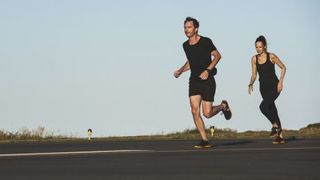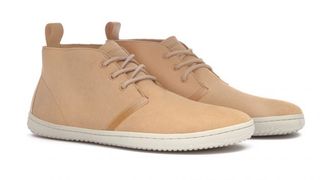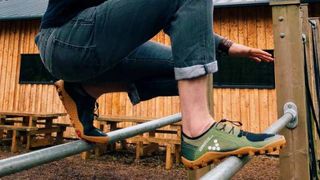How To Transition Safely To Barefoot Running
Making the switch to barefoot running takes time and rushing it risks injury

People have been running barefoot ever since, well, forever, which might make you think you can bin your highly cushioned shoes, slip-on wafer-thin minimalist or “barefoot” kicks, head out for a jog and let nature do its thing. However, this would almost certainly be a big mistake because it’s easy to get injured if you rush the change. It takes most people a long time to make the transition to barefoot shoes because their feet are accustomed to the cushioning and narrow toe-boxes of most modern running shoes.
If you do want to try barefoot running for whatever reason – whether you’re getting injured a lot in regular shoes or just finished reading Born To Run – then check out the advice below from Mark Esteban, coach at barefoot-shoe brand Vivobarefoot. And if you’re not getting injured or experiencing any other issues with cushioned running shoes, then carry on as you are – sticking with what has worked in the past is a golden rule that most runners would benefit from following.
How are barefoot shoes different to other running and lifestyle shoes?
Simply put, barefoot shoes are designed to put as little shoe between the ground and your feet as possible. Barefoot shoes are different to other running and lifestyle shoes – they are wide, thin and flexible. For example, nearly all Vivobarefoot shoes have a 3mm sole, meaning that they have no padding compared with regular lifestyle or running shoes.
Thick, cushioned soles don’t allow your feet to feel the ground, reducing sensory feedback to the brain, which can result in clumsy, unskilful movement. But thin, puncture-resistant soles allow the nerve-endings in our feet to provide your brain with the sensory feedback you need to move with skill.
Barefoot shoes also have a wide toe box – the front of the shoe – which allows the toes to splay. Most running and lifestyle shoes are toe-sprung where the end of the shoe is turned upwards. This elevates the toes off the ground and is usually combined with a tapered, narrow or pointed toe box.
How long does it take to transition to barefoot? Can everyone run barefoot?
It really differs for everyone. There is no average amount of time and there are some people that will never be able to run barefoot, while others will adapt quite easily and quickly. This depends on the extent of the impact of shoes on your foot shape and flexibility or range of movement. What’s most important is that this is never forced or rushed and that people listen to their bodies.
It’s important to note that barefoot shoes are not only for runners, and whether you are a runner or eventually want to lift, cross-train, swim-run or take part in obstacle course races, the sage advice is to walk before you run. In other words, barefoot shoes should be the shoes you spend the most time in – standing and walking.
Get the Coach Newsletter
Sign up for workout ideas, training advice, reviews of the latest gear and more.
So should you start by walking in barefoot lifestyle shoes?
Absolutely. Get rid of your chair if you can at work – stand up straight and spend as much time on your feet as possible to let gravity do its thing. By walking in these shoes and being barefoot at home or in the office, you are essentially putting your feet through rehab – conditioning your feet and improving mobility. Try wearing barefoot shoes for five days out of the week.

Pictured: Vivobarefoot Gobi II Eco Suede Mens (£125)
What potential issues and injuries should you watch out for when you start using barefoot shoes?
Some people find that initially they have some soreness in their feet. They may well ache a little, because you are awakening muscles that have been weakened over time by cramming them into stiff, cushioned shoes that don’t allow your feet to move. Think of taking your shoes off or replacing them with a pair of barefoot shoes as a little like taking your feet to the gym. It will take time for them to adjust, not to mention adapting your running style, but over time the long-term benefits outweigh any initial soreness or discomfort. Just remember that people shouldn’t just switch to barefoot shoes and start running straight away.
What should you look for in non-barefoot shoes in terms of similar features?
You should look for as little shoe as possible and one that is as close to the shape of your foot as possible. If you want to stay in a cushioned world then get a shoe with a wide toe box and flat sole – meaning zero drop. You should avoid shoes with toe boxes turned upwards or a narrow, tapered fit.
How much space should you have between your toes and the front of the shoe?
Getting good fitting advice is an essential part of buying a shoe because making sure your feet have enough room is key. For your feet to start changing you will need between a small finger’s width and a thumb width of space at the end of your shoe – your fitter can advise you. I estimate that around 80% of us are wearing shoes that are too small. Your foot shape will not improve or work if your toes are against the end of the shoe. Your feet need space to flex and recoil.
Is it easier to transition to barefoot running on trails than it is on roads?

This depends on the surface and how hard it is. Contrary to popular belief, runners are more likely to injure themselves on soft ground, because this reduces the efficiency of our elastic recoil due to excessive muscle activity. As the saying goes, “If you ain’t gripping, you’re slipping!” Your footwear has a big impact when running on softer ground. For example, our Primus Trail SG shoes (£120, pictured above) have been designed to provide enough grip to remain stable when your feet connect with the ground.
There are transition benefits to running off-road to do with the variability of surface which shares and changes the load as you move. Start by gradually adding in a variety of surfaces as you transition, and if it is muddy wear a shoe with plenty of grip and take a shorter stride.

Nick Harris-Fry is a journalist who has been covering health and fitness since 2015. Nick is an avid runner, covering 70-110km a week, which gives him ample opportunity to test a wide range of running shoes and running gear. He is also the chief tester for fitness trackers and running watches, treadmills and exercise bikes, and workout headphones.
